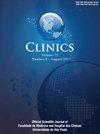Novel variants of the ATRX gene identified in MYCN non-amplified Neuroblastoma in Brazilian patients
IF 2.4
4区 医学
Q2 MEDICINE, GENERAL & INTERNAL
引用次数: 0
Abstract
Background
Neuroblastoma is one of the most common extracranial solid tumors in children and it frequently displays high heterogeneity throughout the course of the disease. It has previously been described those changes in the ATRX gene (Alpha Thalassemia/Mental Retardation, X-linked) are the most common recurring events in the indolent clinical subtype (∼30 %) of MYCN amplified neuroblastoma. There is no effective treatment for this type of neuroblastoma, which is associated with overall poor survival. On the other hand, few studies have detected an association between high-risk (stage IV) non-amplified MYCN neuroblastoma patients and mutant ATRX.
Methods
In this study, 37 tumor samples from Brazilian patients with stages I to IV MYCN non-amplified neuroblastoma, according to the International Neuroblastoma Staging System (INSS), were analyzed using the panel Oncomine™ Childhood Cancer Research Assay.
Results
The authors found two older children (NB1 and NB2) with advanced MYCN non-amplified neuroblastoma carried each one of the two following novel nonsense ATRX variants (p.Gln1670* or p.Glu1984*). These variants created a stop codon in the helicase domain of the ATRX gene, leading to ATRX loss-of-function. These mutations were confirmed by Sanger sequencing and the protein loss-of-function was confirmed by immunohistochemistry. The finding of these heterozygous mutations in two patients with MYCN non-amplified neuroblastoma deserves further investigation. Thus, the authors analyzed each of these cases to better understand how these mutations may be related to disease severity and prognosis.
Conclusion
ATRX loss-of-function from p.Gln1670* or p.Glu1984* mutations turn MYCN non-amplified neuroblastoma more aggressive and similar to what is seen in MYCN amplified neuroblastoma. This information may help clinical decision-making and facilitate establishing an accurate prognosis for patients with MYCN non-amplified neuroblastoma.
在巴西患者的MYCN非扩增神经母细胞瘤中发现了新的ATRX基因变异
神经母细胞瘤是儿童最常见的颅外实体瘤之一,在整个病程中表现出高度的异质性。先前有报道称,在MYCN扩增型神经母细胞瘤的惰性临床亚型(约30%)中,ATRX基因(α地中海贫血/智力低下,x连锁)的变化是最常见的复发事件。这种类型的神经母细胞瘤没有有效的治疗方法,它与总体生存率低有关。另一方面,很少有研究发现高风险(IV期)非扩增型MYCN神经母细胞瘤患者与突变型ATRX之间存在关联。方法在本研究中,根据国际神经母细胞瘤分期系统(INSS),使用Oncomine™儿童癌症研究检测,分析了来自巴西I至IV期MYCN非扩增神经母细胞瘤患者的37例肿瘤样本。结果作者发现两名患有晚期MYCN非扩增神经母细胞瘤的年龄较大的儿童(NB1和NB2)携带了以下两种新的无意义ATRX变体(p.Gln1670*或p.g l1984 *)。这些变异在ATRX基因的解旋酶结构域产生了一个停止密码子,导致ATRX功能丧失。Sanger测序证实了这些突变,免疫组织化学证实了蛋白质功能丧失。在两例MYCN非扩增神经母细胞瘤患者中发现这些杂合突变值得进一步研究。因此,作者分析了这些病例,以更好地了解这些突变如何与疾病严重程度和预后相关。结论p.Gln1670*或p.Glu1984*突变引起的atrx功能丧失使MYCN非扩增型神经母细胞瘤更具侵袭性,且与MYCN扩增型神经母细胞瘤相似。这些信息可能有助于临床决策,并有助于MYCN非扩增型神经母细胞瘤患者建立准确的预后。
本文章由计算机程序翻译,如有差异,请以英文原文为准。
求助全文
约1分钟内获得全文
求助全文
来源期刊

Clinics
医学-医学:内科
CiteScore
4.10
自引率
3.70%
发文量
129
审稿时长
52 days
期刊介绍:
CLINICS is an electronic journal that publishes peer-reviewed articles in continuous flow, of interest to clinicians and researchers in the medical sciences. CLINICS complies with the policies of funding agencies which request or require deposition of the published articles that they fund into publicly available databases. CLINICS supports the position of the International Committee of Medical Journal Editors (ICMJE) on trial registration.
 求助内容:
求助内容: 应助结果提醒方式:
应助结果提醒方式:


